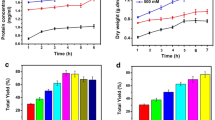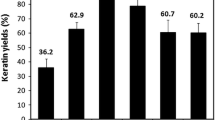Abstract
The structure and properties of chicken feather barbs makes them unique fibers preferable for several applications. The presence of hollow honeycomb structures, their low density, high flexibility and possible structural interaction with other fibers when made into products such as textiles provides them unique properties unlike any other natural or synthetic fibers. No literature is available on the physical structure and tensile properties of chicken feather barbs. In this study, we report the physical and morphological structure and the properties of chicken feather barbs for potential use as natural protein fibers. The morphological structure of chicken feather barbs is similar to that of the rachis but the physical structure of the protein crystals in chicken feather barbs is different than that reported for feather rachis keratin. The tensile properties of barbs in terms of their strength and modulus are similar but the elongation is lower than that of wool. Using the cheap and abundant feathers as protein fibers will conserve the energy, benefit the environment and also make the fiber industry more sustainable









Similar content being viewed by others
References
Barone JR, Schmidt WF (2005) Compos Sci Technol 65:173–181
Jones LN, Riven DE, Tucker DJ (1998) Handbook of fiber chemistry, Marcel Dekker, Inc., New York
Reddy N, Yang Y (2005) Trends Biotech 23(1):22–27
Reddy N, Yang Y (2005) Green Chem 7(4):190–195
Reddy N, Yang Y (2005) AATCC Rev 5(7):24–27
Reddy N, Yang Y (2005) Polymer 46(15):5494–5500
Reddy N, Yang Y (2006) J Agri Food Chem 54:8077–8081
Doraiswamy I, Chellamani P (1993) Text Prog 24(1):1–29
Ganjyal G, Reddy N, Yang Y, Hanna M (2004) J Appl Polym Sci 93:2627–2633
Yang Y, Wang L, Li S (1996) J Appl Polym Sci 59:433–441
Huang HC, Hammond EG, Reitmeier CA, Myers DJ (1995) J Am Oil Chem Soc 72(12):1453–1460
Boyer RA (1940) Ind Eng Chem 32(12):1549–1551
Winandy JE, Muehl JH, Micales JA, Raina A, Schmidt W (2003) In: Proceedings of EcoComp 2003, Queen Mary, University of London, September 1–2, 1–6
Evazynajad A, Kar A, Veluswamy S, McBride H, George BR (2002) Mat Res Soc Symp Proc 702:U1.2–U1.4
Hernandez-Martinez AL, Santos-Velasco C, Icaza de M, Castano VM (2005) Int J Environ Pollut 23(2):162–178
Cameron GJ, Wess TJ, Bonser RHC (2003) J Struct Biol 143:118–123
Pauling L, Corey RB (1951) Proc Natl Acad Sci 37:256–258
Kraut J (1954) Thesis submitted to California Institute of Technology, 117–151
Gibson LJ (2005) J Biomech 38:377–399
Butler M, Johnson AS (2004) J Exp Biol 207:285–293
Cao J, Billows CA (1999) Polym Int 48:1027–1033
Fraser RDB, Macrae TP (1980) Sym Soc Exp Biol 34:211–246
Venkateshwarlu K, Pillai SP (1960) J Appl Polym Sci 4(11):175–178
Acknowledgements
The authors would like to thank Brian Jones with the Center for Materials Research and Analysis in the Physics Department at the University of Nebraska-Lincoln for his help in the X-ray characterization studies. The authors are indebted to the financial support from the University of Nebraska-Lincoln Agricultural Research Division and the support through the Hatch Act
Author information
Authors and Affiliations
Corresponding author
Rights and permissions
About this article
Cite this article
Reddy, N., Yang, Y. Structure and Properties of Chicken Feather Barbs as Natural Protein Fibers. J Polym Environ 15, 81–87 (2007). https://doi.org/10.1007/s10924-007-0054-7
Published:
Issue Date:
DOI: https://doi.org/10.1007/s10924-007-0054-7




